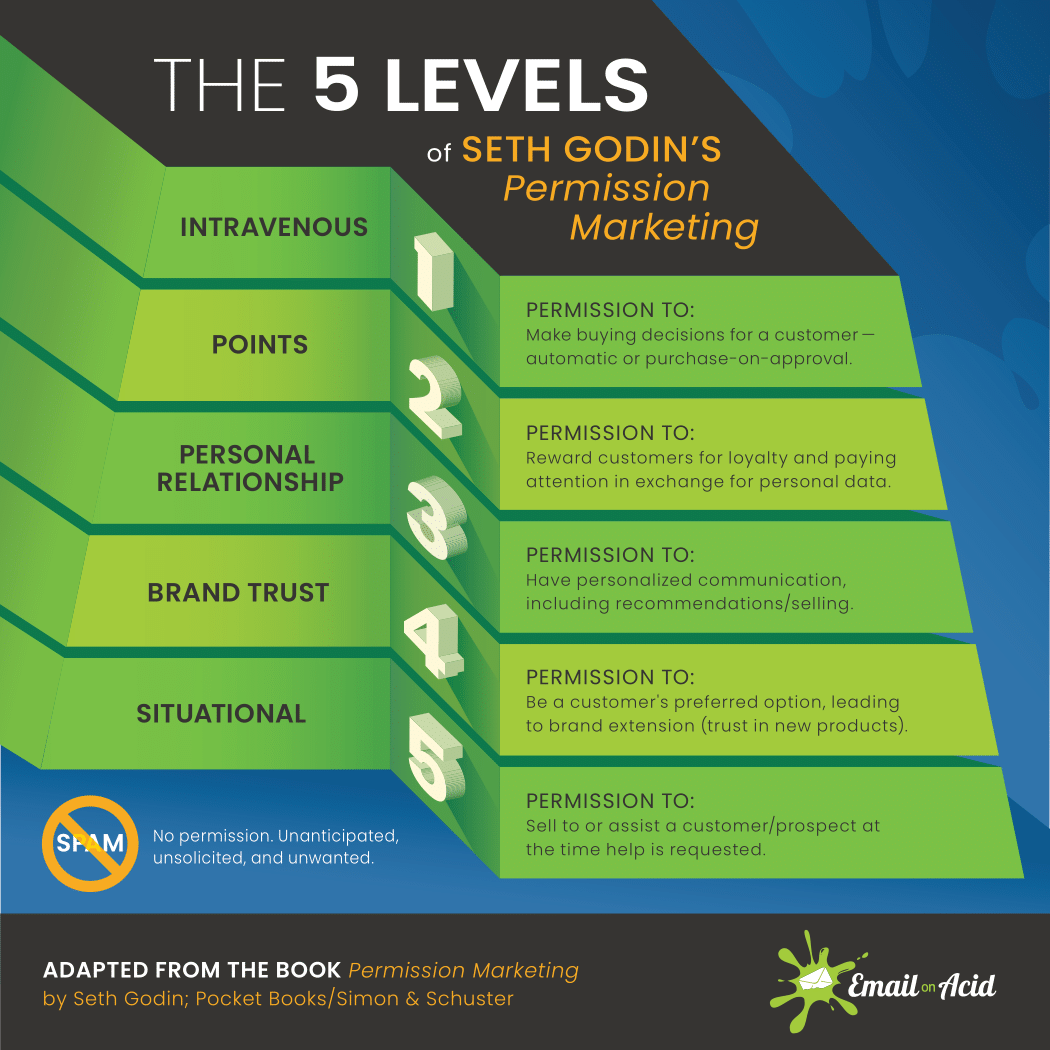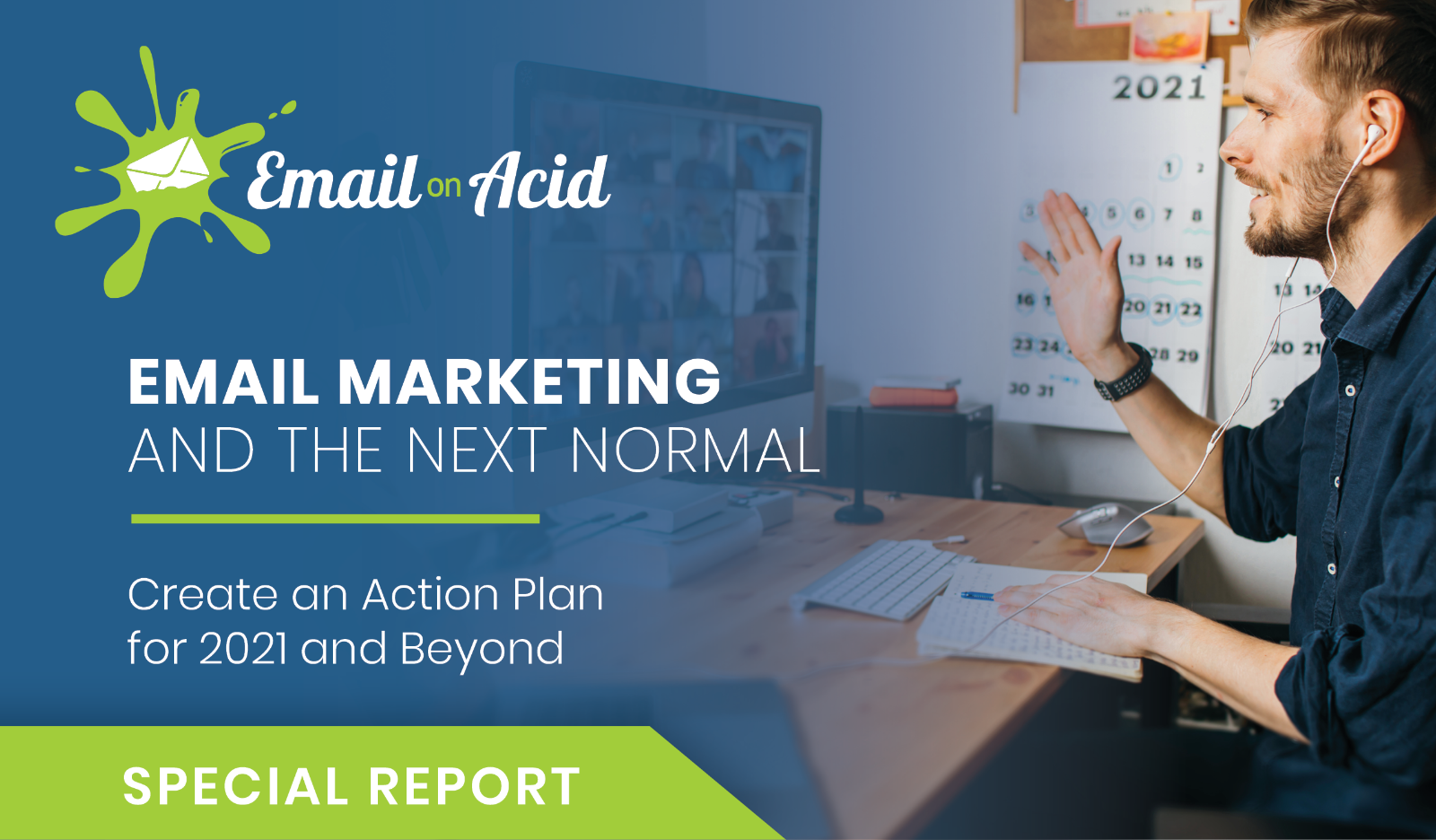Email Marketing
Enduring Insights from Seth Godin’s Permission Marketing

Email Marketing

Things change fast in the digital world. You probably wouldn’t expect a book about online marketing written more than two decades ago to maintain its relevance. Seth Godin’s groundbreaking 1999 book, Permission Marketing, is a clear exception.
In 1999, I was a senior in high school and still trying to convince my dad we needed dial-up internet. Little did I know that Seth and the team at his digital agency, Yoyodyne, were pioneering the practice of email marketing and other ideas that would end up defining my career (probably yours, too).
The mindset described in Permission Marketing will make a lot of sense to marketers in 2021. 20 years ago, however, it was a mind–shift that was hard for many to accept. In fact, Seth says he was kicked out of the Direct Marketing Association for what he wrote.
Amazingly, Seth never updated this influential book, aside from writing a new introduction in 2007. While he admits that he didn’t get everything right, parts of the book seem downright prophetic.
For example, Permission Marketing, calls out the savviness of Amazon.com’s strategy when it was still just an online bookstore and Jeff Bezos was “on his way to becoming a billionaire.” The book also alludes to the idea of the Internet of Things (IoT) long before it entered the mainstream.
Unfortunately, some of us still use the same tired tactics that Seth warns against. What timeless lessons does Permission Marketing provide, and what can it tell us about the future of email? Let’s take a closer look and hear from the author himself.
I decided to cold email Seth Godin out of the blue to see if he’d be willing to share some of his trademark nuggets of marketing wisdom as we mark 50 years since email’s invention. He might be the most generous person on the internet. So, I wasn’t surprised he wrote back, but I was impressed that he responded within minutes!
First, I asked about the most enduring takeaway from the concepts he outlined in 1999:
“When I wrote Permission Marketing, email was a zero billion dollar industry. I’d been developing Yoyodyne for 8 years by then–we invented email marketing as a non-spam commercial activity, and it’s bigger than ever. The most important lesson is still the same: Attention is scarce and it doesn’t belong to you. You can earn it, but you can’t reliably demand it. If we bring humility to the table, understanding that we’re using something that can never be replaced, we have a better chance of serving our customers.”

Attention is at the core of everything we try to do as marketers, isn’t it? There are a lot of different ways of getting attention. Seth often points out that we pay attention, which is why we must earn it from the people we want to reach.
The simple, yet revolutionary notion he explains in Permission Marketing is that, rather than constantly screaming at the people you want to reach, it’s far more effective to put effort into talking to the people who actually want to hear from you.
Seth describes most traditional advertising as “Interruption Marketing.” A commercial interrupts your sitcom or the Top 40 music on the radio. Billboards interrupt the scenery along the highway. Pop-up ads on websites and midroll ads on YouTube are interruptions too.
The problem then and now is that we’re all inundated with these interruptions. There are so many that we tune them out because time and attention are scarce, valuable resources. Seth wrote that Interruption Marketing is expensive and largely ineffective, but that hasn’t stopped most marketers …
The ironic thing is that marketers have responded to this problem with the single worst cure possible. To deal with the clutter and the diminished effectiveness of Interruption Marketing, they’re interrupting us even more!
Permission Marketing is different. When you earn attention and someone gives you permission to communicate with them (often by handing over their email address), you’ve got something that’s much more valuable. You have the opportunity to build a lasting relationship with someone who is interested in what you’re saying and selling.
The goal of the Permission Marketer is to move consumers up the permission ladder, moving them from strangers to friends to customers. And from customers to loyal customers. At every step up the ladder, trust grows, responsibility grows, and profit grows.
You can easily apply the foundations of Permission Marketing to email strategy:
Update: After checking out our article, Seth pointed out there’s a difference between being personal and personalization. We can use personalization to be personal, but simply sticking a subscriber’s name in the subject line doesn’t make email marketing personal.
There is a bit of a Catch-22 here. In order to get permission to market to an audience, you almost always need to interrupt them at least once. It’s what happens after that initial interruption that really matters.

Seth uses dating and marriage proposals to illustrate the difference between Interruption and Permission Marketing. The analogy makes it easy to see how ridiculous it is to assume interrupting prospects is a good idea.
Walking into the singles bar, the Interruption Marketer marches up to the nearest person and proposes marriage. If turned down, the Interruption Marketer repeats this process on every person in the bar.
The Interruption Marketer may be good-looking, nicely dressed, and have fresh breath, but it doesn’t make much sense to ask people to immediately make a commitment like marriage. Likewise, it’s unrealistic to expect that people will buy a product, subscribe to a service, or choose you as a business partner after seeing an ad – no matter how slick it may be.
At its best, Interruption Marketing is good for brand awareness and potentially starting a conversation. But if that’s your entire strategy, you’re going to fall short and you’re going to annoy people. The other option is to take things slow.
A Permission Marketer goes on a date. If it goes well, the two of them go on another date. And then another … And finally, after three or four months of dating, the Permission Marketer proposes marriage.
The idea of “dating” your customers and prospects makes a lot more sense. Of course, you’ll still have to introduce yourself and ask them out. That’s the necessary interruption. But instead of asking for a prospect’s hand in marriage, you strike up a conversation, ask to buy them a drink, and then ask if you can have their phone number. Even better … maybe they’re interested in you and approach you at the bar first. That means you don’t need to interrupt them at all.
In real marketing terms, it’s like having someone discover your website through organic search. Then you give them a free eBook in exchange for their email address. Now you’ve got permission to contact them and ask them out on more “dates.” Those follow-up dates are where your email nurture track comes into the picture.
Your prospects may go on dates with other brands as they compare their options. It’s your job to keep them interested and prove to them that you’re the best choice. Do it well, time it right, and when you ask for a commitment, you’ll be much more likely to get a “Yes”.
There are different types of permissions that customers and prospects give. We’ve illustrated them in the infographic below:

Intravenous permission is when a customer allows a company to make purchases for them. Seth calls this the highest level of permission. It includes subscription services like Stitch Fix or Birchbox. In that case, customers trust the brand to make decisions for them based on personal preferences they’ve told the brand about. SaaS and eCommerce businesses that automatically renew or auto-ship products at a certain time fall into this category as well.
The Points level of permission could take the form of a loyalty/rewards program. I also think the practice of providing high-value content in exchange for information falls into this category. While it’s not a literal points program, it’s a way of giving something to prospects with the goal of keeping them engaged.
The Personal Relationship level is the most familiar type. People give your brand permission to email them and continue a conversation, including selling to them and recommending purchases. Seth calls this level of permission powerful but admits it’s tough to scale. The key is identifying the right relationships on which to focus your efforts.
Brand trust is where many Interruption Marketers place their bets, and it actually is a worthwhile endeavor. The problem is it’s expensive, you can’t measure it accurately, and there’s no guarantee it will work. When consumers trust your brand, they give you permission to be their top choice. They may extend their permission to new offerings because you’ve built that trust. “I like Doritos, so I bet I’ll like this new flavor.” “I trust my credit union, so I’m going to them first if I need a loan.”
The Situational level of permission involves times when a customer or prospect approaches you for information, opening the door for you to help them and potentially persuade them to make a purchase decision. That could include times when someone uses a chatbox or a contact form to find out more or signs up for a product demo. You get permission to talk with them at a specific time for a certain reason.
Spam falls outside the realm of Permission Marketing. It is pure Interruption Marketing. Avoid it at all costs.
In a webinar with SharpSpring, Seth mentioned that he got his first email address in 1976. Talk about an early adopter! He’s been watching this marketing channel grow since the very beginning. So, his advice about where email is heading and how to use it wisely is worth heeding.
In his email response, Seth told me there’s a “fork in the road,” and we need to choose the right path:
Either you’re a spammer or you’re not. Either you’re regularly skirting the edges, trading lists, hustling people, writing link bait subject lines, evading policies and skulking around, OR, you’re being clear and open and delivering messages that are anticipated, personal and relevant.
The test is easy: If you didn’t send out your emails tomorrow, would people contact you to find out what happened?

You can use our email marketing readiness platform to test campaigns before you hit send, and you can use Email Analytics to see how subscribers respond. Email on Acid can help you deliver email perfection, but the tools won’t improve your strategy or even the quality of the content in your campaigns.
That responsibility falls on us as modern marketers, and it’s why Seth’s final comment in his response to my question is a little bit scary. He thinks email marketing could be doomed:
Email’s an open API, and that will probably doom it in the long run. But if enough marketers stand up and make it better, not simply louder, there’s a shot…
Seth has said that if postage were free, we’d get even more print junk mail in our mailboxes than ever. Email is an extremely low-cost marketing channel, which regrettably led to spam, malicious scams, selling lists, and other unfortunate side effects. It was inevitable, and it could be email’s undoing, unless we all do something to avoid the fate of people abandoning their inboxes for something with fewer unwanted interruptions.
Email, like many powerful tools, can be used for good or evil. It can be used to add value to people’s lives or to annoy them into unsubscribing. The future of email is in our hands. Let’s “make it better, not simply louder.”
For more on the future of email, be sure to register for the first in our three-part webinar series with emfluence. We’re starting with a look back at Lessons Learned from 50 Years of Email – and don’t miss our history of email timeline.
I can’t recommend Seth Godin’s work enough. If you’re interested in learning more about Permission Marketing, he’s released the first four chapters of the book for free on his website. I also suggest making a habit out of reading Seth’s Blog. His daily posts are typically brief — but poignant and powerful.
Seth’s 2018 book, This is Marketing, is a guide for marketers of all types, and it could be considered a follow-up to Permission Marketing. His newest book, The Practice: Shipping Creative Work, came out recently and is a NY Times bestseller. Watch the book trailer below for more. You can also check out Seth’s podcast, Akimbo.
What do you think? Does Seth Godin’s Permission Marketing hold up in 2021? Let us know in the comments!
Our special report, Email Marketing and the Next Normal, takes a look at how recent events are changing the practice. From COVID-19 to social justice reform and the economy — there’s much to be learned from the year 2020.
Get an email marketing action plan with ten suggestions for adjusting your strategy as we move forward.
